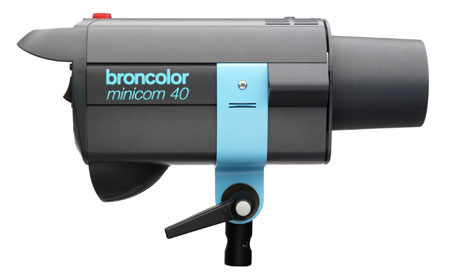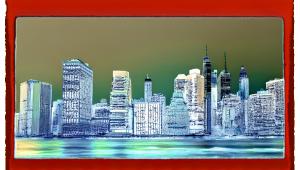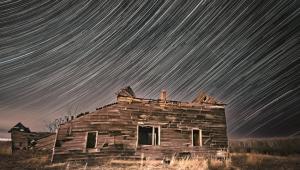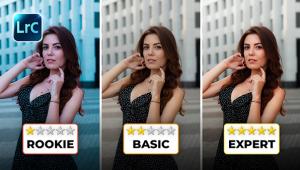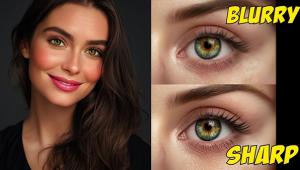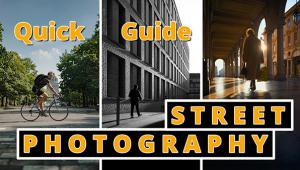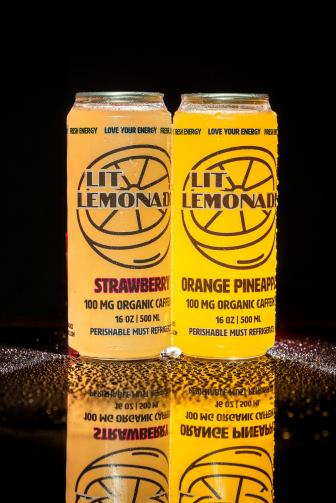A Sinar Bron Studio Setup
| The Topaz A2, which powers the Ringflash, is a full-size power pack with 1600 ws output that features symmetrical/asymmetrical power distribution. |
Umbrella & Stand
Because of its size and weight, the studio gear requires careful setup. It's
important to match the stand with the umbrella and strobe head being used. The
Senior is a light stand with two air-cushioned height extensions and 3/8"
thread bolt. It can be extended from 3 ft to 8 ft, 8". Make sure that
the stand is extended to the maximum width possible before attaching the umbrella.
Along the same lines, if the individual position locks aren't totally
secure, the entire umbrella could fall. That's the case with any lighting
setup, but it's even more of an issue in this case because of size and
weight.
Designed with extendable braces, the Para 170 FB is a parabolic umbrella with
a diameter of 170 centimeters (5', 7"). It's a large dish
with a highly reflective silver coating and a very efficient front focusing
device. In most cases, the larger the umbrella, the more pleasing the quality
of light that can be generated. That's one of the reasons that high-end
commercial photographers tend to go with oversized umbrellas, light boxes, and
other light-modifying devices.
Such giant umbrellas as the Para 170 are used in shooting people, glamour, and
fashion. While they certainly can be used on location, they're intended
more for controlled environments, such as studios. They can generate a brilliant
light that envelops the subject in a cloud of light, yet maintaining textured
detail. With the Para FBs, the lamp base can be focused precisely, making it
possible to adjust the quality of the light from very soft to quite hard, all
with negligible edge falloff.
Because it is so large, the umbrella sets up differently than most umbrella
systems. There's a crank handle on the back. Open it up partially by hand.
Once it's been opened up partially, it's easy to crank it tight.
The parabolic shape needs to be tight, but don't over-crank it. That could
damage the umbrella or the plastic braces.
The Strobe
The Minicom 40 is positioned on the front of the umbrella shaft. It's
billed as the next level in Broncolor compact flash units. Applicable for either
digital or traditional film photography, it's a compact head with a full
range of controls and illuminated digital display for power output. It includes
scratchproof silicone keypads on the back of the unit with controls for cell
(slave) and IR triggering, modeling light, and test firing. There are also two
sync cord connectors and a power cord socket on the back of the unit. It's
designed with advanced microelectronic components that reduce its weight and
size.
|
|
|
|
The Minicom 40 is available in a RFS version for remote triggering either
from an RFS radio frequency transmitter, from Broncolor's new Servo RFS,
or from a personal computer. It's compatible with either PCs or Macs.
Ten digital radio channels are available for precise remote triggering of specific
heads.
Balance It
Generally, lighting gear is more stable when cord-connecting points are directly
over the stand shaft or as close to the center of gravity as possible. With
the considerable weight of the strobe already extended to the end of the umbrella
shaft, a tug could easily pull the whole thing down if it hasn't been
assembled properly. To avoid that possibility, run the lamp head cable through
the opening in the umbrella cove behind the umbrella.
In The Studio
The head and umbrella combination can throw out a considerable amount of light.
At 8 ft and full power, the setup generates enough light for an f/16 exposure.
Minimum power drops the exposure at the same distance to f/2.8. Color temperature
was very consistent. The maximum deviation was only +/- 90K from 5100K.
Size has advantages in the quality of light, but it also has its disadvantages.
For one thing, to set up a complete lighting system takes up a lot of room,
much more than the average lighting system. For another, making positioning
adjustments is more complicated. A special leverage bar is provided that makes
it easier to change the umbrella position.
The Ringflash
Ringlights are specialized pieces of equipment that are ideal for providing
direct lighting. Able to produce lots of light, without shadows, they're
used in fashion and some types of product photography. I've played with
ringlights before, but nothing quite as powerful as this unit. Quite frankly,
I haven't quite mastered them yet. Still, I like working with them because
they are so unusual. With a ringlight, the camera is mounted on an adjustable
bracket with the lens extending through the center of the ring. When the flash
is popped, there's very even light directly in front of the lens.
Broncolor's ringlight, the Ringflash, is a circular 3200 ws head that
can produce perfectly shadowless lighting or the unique cross shadow effect.
Its oversized 4" center opening and sturdy bracket makes it possible to
use it with just about any camera/lens combination, including longer telephoto
lenses. The Ringflash throws out plenty of light, even for telephoto work. It
can be used with any of Broncolor's packs that go up to 3200 ws. Because
of its design, the company recommends that the Ringflash should not be fired
for more than a total of 9600 ws per minute to avoid damage to the unit.
 |
|
|
The Ringflash is powered by a Topas A2, a full-size power pack with 1600 ws
output that features symmetrical/asymmetrical power distribution. It has individual
lamp head control over a five f/stop range, in 1/10 stop increments. There's
automated stabilization of the color temperature. Compatible with most of Broncolor's
light-generating devices, it has infrared or white light triggering capabilities.
It's possible to program the internal memory for up to eight flash sequences
for special effects and multiple flash sequences. It has basically the same
control panel layout as the Minicom 40.
The Ringflash is powerful. At 8 ft, at maximum power, it generates enough light
for an f/22 exposure. With minimum power, the exposure is f/5.6 at the same
distance. The color temperature ranged from 5700K to 5780K, over a series of
a half a dozen exposures. Since it is a direct light source (rather than a reflective
or diffused light), and it is extremely powerful, be careful how it's
used to avoid potential eye damage.
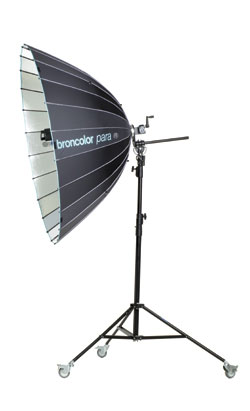 |
|
|
The Para umbrella costs $3783.25, the Minicom 40 $1351.75 ($1779 with RFS),
and the Senior stand $249.95. The Ringflash has a price of $2163.50 and the
Topas 2A lists for $3443.
The Broncolor Para setup and Ringflash aren't for every photographer.
They're large, they're bulky, and they're relatively expensive.
But, in shooting situations where power and control are important, they might
be the ultimate lighting solution.
For more information, contact Sinar Bron Imaging, 17 Progress St., Edison, NJ
08820; (908) 754-5800; www.sinarbron.com.
- Log in or register to post comments
